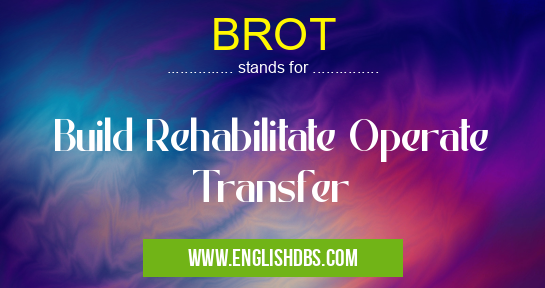What does BROT mean in BUSINESS
BROT is an abbreviation for Build, Rehabilitate, Operate and Transfer. This acronym is used in the construction industry to refer to the four stages involved in the development of a project from conception to completion. The process can be applied to any type of project, from large-scale infrastructure such as roads and bridges, to smaller projects like office buildings or residential developments. BROT enables developers and contractors to efficiently manage every stage of a project's development, resulting in better outcomes for all stakeholders involved.

BROT meaning in Business in Business
BROT mostly used in an acronym Business in Category Business that means Build Rehabilitate Operate Transfer
Shorthand: BROT,
Full Form: Build Rehabilitate Operate Transfer
For more information of "Build Rehabilitate Operate Transfer", see the section below.
Essential Questions and Answers on Build Rehabilitate Operate Transfer in "BUSINESS»BUSINESS"
What does "Build" mean in BROT?
In the context of BROT, ‘build' refers to the stage where physical works are undertaken on a project — such as construction, installation and commissioning. At this stage, contractors are responsible for procuring materials and equipment, appointing subcontractors and managing resources throughout the duration of the construction phase.
What does "Rehabilitate" mean?
Rehabilitation is one of the key stages in a BROT process and involves assessing existing conditions or structures that need improvement or renewal. Examples of rehabilitation activities include refurbishment work or upgrades that may be necessary before further construction can take place.
What is "Operate"?
During the operation phase of BROT, contractors are responsible for overseeing operations at an agreed level until transfer takes place. They must also ensure that all safety requirements are met during this period and provide regular reports on progress to stakeholders if required.
What is meant by "Transfer"?
Transfer is the final stage in a BROT process. At this point ownership is formally transferred from one party to another — either from contractor back to developer or from one developer/contractor combination to another party entirely — following successful completion of all works associated with the project.
How does BROT benefit stakeholders?
The use of BROT provides numerous benefits for all stakeholders involved in a project. By streamlining each stage using established procedures, costs can be reduced while quality control can be more effectively monitored throughout every phase of its development. Contractors also benefit through clearer contracts which protect their interests while providing greater focus on delivering results consistently throughout the build cycle.
Final Words:
In summary, BROT offers increased efficiency within construction projects by breaking down each individual task into recognizable steps that enable better planning and management along with enhanced cost savings. With its flexibility across different types of projects it ensures better outcomes for all parties involved.
